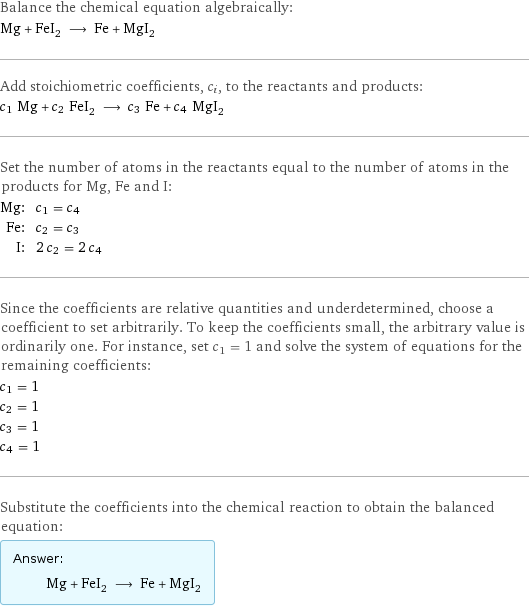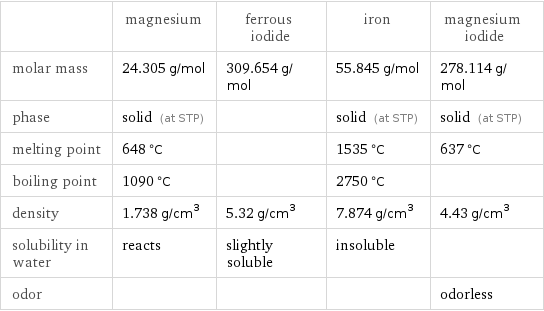Input interpretation

Mg magnesium + FeI_2 ferrous iodide ⟶ Fe iron + MgI_2 magnesium iodide
Balanced equation

Balance the chemical equation algebraically: Mg + FeI_2 ⟶ Fe + MgI_2 Add stoichiometric coefficients, c_i, to the reactants and products: c_1 Mg + c_2 FeI_2 ⟶ c_3 Fe + c_4 MgI_2 Set the number of atoms in the reactants equal to the number of atoms in the products for Mg, Fe and I: Mg: | c_1 = c_4 Fe: | c_2 = c_3 I: | 2 c_2 = 2 c_4 Since the coefficients are relative quantities and underdetermined, choose a coefficient to set arbitrarily. To keep the coefficients small, the arbitrary value is ordinarily one. For instance, set c_1 = 1 and solve the system of equations for the remaining coefficients: c_1 = 1 c_2 = 1 c_3 = 1 c_4 = 1 Substitute the coefficients into the chemical reaction to obtain the balanced equation: Answer: | | Mg + FeI_2 ⟶ Fe + MgI_2
Structures

+ ⟶ +
Names

magnesium + ferrous iodide ⟶ iron + magnesium iodide
Equilibrium constant
![Construct the equilibrium constant, K, expression for: Mg + FeI_2 ⟶ Fe + MgI_2 Plan: • Balance the chemical equation. • Determine the stoichiometric numbers. • Assemble the activity expression for each chemical species. • Use the activity expressions to build the equilibrium constant expression. Write the balanced chemical equation: Mg + FeI_2 ⟶ Fe + MgI_2 Assign stoichiometric numbers, ν_i, using the stoichiometric coefficients, c_i, from the balanced chemical equation in the following manner: ν_i = -c_i for reactants and ν_i = c_i for products: chemical species | c_i | ν_i Mg | 1 | -1 FeI_2 | 1 | -1 Fe | 1 | 1 MgI_2 | 1 | 1 Assemble the activity expressions accounting for the state of matter and ν_i: chemical species | c_i | ν_i | activity expression Mg | 1 | -1 | ([Mg])^(-1) FeI_2 | 1 | -1 | ([FeI2])^(-1) Fe | 1 | 1 | [Fe] MgI_2 | 1 | 1 | [MgI2] The equilibrium constant symbol in the concentration basis is: K_c Mulitply the activity expressions to arrive at the K_c expression: Answer: | | K_c = ([Mg])^(-1) ([FeI2])^(-1) [Fe] [MgI2] = ([Fe] [MgI2])/([Mg] [FeI2])](../image_source/d327aac157a2fa29b7f2d309bee52c1b.png)
Construct the equilibrium constant, K, expression for: Mg + FeI_2 ⟶ Fe + MgI_2 Plan: • Balance the chemical equation. • Determine the stoichiometric numbers. • Assemble the activity expression for each chemical species. • Use the activity expressions to build the equilibrium constant expression. Write the balanced chemical equation: Mg + FeI_2 ⟶ Fe + MgI_2 Assign stoichiometric numbers, ν_i, using the stoichiometric coefficients, c_i, from the balanced chemical equation in the following manner: ν_i = -c_i for reactants and ν_i = c_i for products: chemical species | c_i | ν_i Mg | 1 | -1 FeI_2 | 1 | -1 Fe | 1 | 1 MgI_2 | 1 | 1 Assemble the activity expressions accounting for the state of matter and ν_i: chemical species | c_i | ν_i | activity expression Mg | 1 | -1 | ([Mg])^(-1) FeI_2 | 1 | -1 | ([FeI2])^(-1) Fe | 1 | 1 | [Fe] MgI_2 | 1 | 1 | [MgI2] The equilibrium constant symbol in the concentration basis is: K_c Mulitply the activity expressions to arrive at the K_c expression: Answer: | | K_c = ([Mg])^(-1) ([FeI2])^(-1) [Fe] [MgI2] = ([Fe] [MgI2])/([Mg] [FeI2])
Rate of reaction
![Construct the rate of reaction expression for: Mg + FeI_2 ⟶ Fe + MgI_2 Plan: • Balance the chemical equation. • Determine the stoichiometric numbers. • Assemble the rate term for each chemical species. • Write the rate of reaction expression. Write the balanced chemical equation: Mg + FeI_2 ⟶ Fe + MgI_2 Assign stoichiometric numbers, ν_i, using the stoichiometric coefficients, c_i, from the balanced chemical equation in the following manner: ν_i = -c_i for reactants and ν_i = c_i for products: chemical species | c_i | ν_i Mg | 1 | -1 FeI_2 | 1 | -1 Fe | 1 | 1 MgI_2 | 1 | 1 The rate term for each chemical species, B_i, is 1/ν_i(Δ[B_i])/(Δt) where [B_i] is the amount concentration and t is time: chemical species | c_i | ν_i | rate term Mg | 1 | -1 | -(Δ[Mg])/(Δt) FeI_2 | 1 | -1 | -(Δ[FeI2])/(Δt) Fe | 1 | 1 | (Δ[Fe])/(Δt) MgI_2 | 1 | 1 | (Δ[MgI2])/(Δt) (for infinitesimal rate of change, replace Δ with d) Set the rate terms equal to each other to arrive at the rate expression: Answer: | | rate = -(Δ[Mg])/(Δt) = -(Δ[FeI2])/(Δt) = (Δ[Fe])/(Δt) = (Δ[MgI2])/(Δt) (assuming constant volume and no accumulation of intermediates or side products)](../image_source/ebfa74b5dc1dcf5747c4cef8aa764491.png)
Construct the rate of reaction expression for: Mg + FeI_2 ⟶ Fe + MgI_2 Plan: • Balance the chemical equation. • Determine the stoichiometric numbers. • Assemble the rate term for each chemical species. • Write the rate of reaction expression. Write the balanced chemical equation: Mg + FeI_2 ⟶ Fe + MgI_2 Assign stoichiometric numbers, ν_i, using the stoichiometric coefficients, c_i, from the balanced chemical equation in the following manner: ν_i = -c_i for reactants and ν_i = c_i for products: chemical species | c_i | ν_i Mg | 1 | -1 FeI_2 | 1 | -1 Fe | 1 | 1 MgI_2 | 1 | 1 The rate term for each chemical species, B_i, is 1/ν_i(Δ[B_i])/(Δt) where [B_i] is the amount concentration and t is time: chemical species | c_i | ν_i | rate term Mg | 1 | -1 | -(Δ[Mg])/(Δt) FeI_2 | 1 | -1 | -(Δ[FeI2])/(Δt) Fe | 1 | 1 | (Δ[Fe])/(Δt) MgI_2 | 1 | 1 | (Δ[MgI2])/(Δt) (for infinitesimal rate of change, replace Δ with d) Set the rate terms equal to each other to arrive at the rate expression: Answer: | | rate = -(Δ[Mg])/(Δt) = -(Δ[FeI2])/(Δt) = (Δ[Fe])/(Δt) = (Δ[MgI2])/(Δt) (assuming constant volume and no accumulation of intermediates or side products)
Chemical names and formulas

| magnesium | ferrous iodide | iron | magnesium iodide formula | Mg | FeI_2 | Fe | MgI_2 Hill formula | Mg | FeI_2 | Fe | I_2Mg name | magnesium | ferrous iodide | iron | magnesium iodide IUPAC name | magnesium | diiodoiron | iron | magnesium diiodide
Substance properties

| magnesium | ferrous iodide | iron | magnesium iodide molar mass | 24.305 g/mol | 309.654 g/mol | 55.845 g/mol | 278.114 g/mol phase | solid (at STP) | | solid (at STP) | solid (at STP) melting point | 648 °C | | 1535 °C | 637 °C boiling point | 1090 °C | | 2750 °C | density | 1.738 g/cm^3 | 5.32 g/cm^3 | 7.874 g/cm^3 | 4.43 g/cm^3 solubility in water | reacts | slightly soluble | insoluble | odor | | | | odorless
Units
